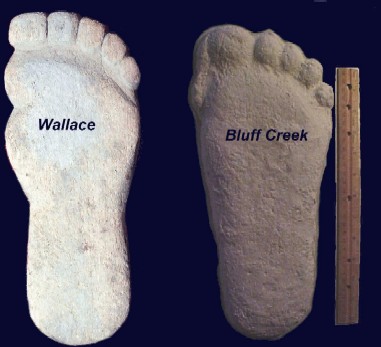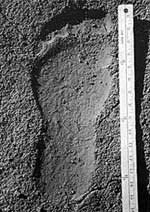
May 27, 2006

Ray Wallace lives on. Memorial Day weekend is a good time to reflect on the ones that have passed along, and notice their impact. Positively and negatively. It is also a time to renew the cry to remove the bad data, remove the fakery in our midst, remove the Wallace fake track photos from the Bigfoot books out there.
Less than a month ago, another overview article in another Pacific Northwest newspaper decided to talk about Wallace:
The best known local Bigfoot trickster was the late Ray Wallace, a Toledo man whose family said helped create the Bigfoot legend.
In 1958, Wallace made giant footprints at a work site in Humboldt County, Calif., that were reported by a local newspaper the next day.
Wallace continued Bigfoot pranks when he returned to Washington, even having his wife dress up as one of the half-human wilderness creatures, relatives said.
But Ray Crowe of the International Bigfoot Society in Hillsboro, Ore., said Wallace was a true believer and pulled some of the pranks to throw critics off the track.
Of course, Ray Wallace didn’t create "the Bigfoot legend," and I won’t exactly say he "helped" it along either.
The Bluff Creek incidents of 1958 involved two different kinds of footprints, and that simple fact appears to still escape journalists five years after Wallace’s death.
The evidence to this is in plaster and wood, so obviously demonstrated below.

Beyond the obvious above, however, maybe Ray Crowe is correct on a level overlooked by modern Bigfooters. Isn’t Ray Wallace able to still throw people off the "track" because his fakes continue to populate the pages of so many new books on the subject?
Unfortunately, the imprints left by the Wallace fakes still haunt us in the uncritical photographs in newly published and old reprints of Sasquatch books. These "perfect footprints" are held up as actual evidence of a real creature passing that way. But indeed, the Wallace pranks continued on around the Blue Creek-Bluff Creek area throughout the 1960s.

Today, it seems, Bigfoot researchers are confronted with a future full of Wallace fakes in several new books. These recycled texts hide old sins, and serve to distract with an incorrect database, as so many of these prints continue to be uncritically labeled as "real." It seems that if some pieces of evidence deserve astericks in revised volumes, surely these “tracks” – probable Wallace fakes – do.
Memorial Day Weekend is a good time to reflect, while it rains outside, or after a long day of outdoor activities, on how we can move on from the death of Wallace. Begin the process. Thumb through your Sasquatch books. Take the steps to a more critically-aware cryptozoological future: Acknowledge the fakes, remove them, and promote the best evidence.

Compare the Ray Wallace fake wooden carved foot, on the right, with the photograph of an alleged "real" Bigfoot footprint found in many books, above. The Wallace creation would have been worn and pressed in fine dirt – thus its reverse image was left. Rubert photo, used by permission.
About Loren Coleman
Loren Coleman is one of the world’s leading cryptozoologists, some say “the” leading living cryptozoologist. Certainly, he is acknowledged as the current living American researcher and writer who has most popularized cryptozoology in the late 20th and early 21st centuries.
Starting his fieldwork and investigations in 1960, after traveling and trekking extensively in pursuit of cryptozoological mysteries, Coleman began writing to share his experiences in 1969. An honorary member of Ivan T. Sanderson’s Society for the Investigation of the Unexplained in the 1970s, Coleman has been bestowed with similar honorary memberships of the North Idaho College Cryptozoology Club in 1983, and in subsequent years, that of the British Columbia Scientific Cryptozoology Club, CryptoSafari International, and other international organizations. He was also a Life Member and Benefactor of the International Society of Cryptozoology (now-defunct).
Loren Coleman’s daily blog, as a member of the Cryptomundo Team, served as an ongoing avenue of communication for the ever-growing body of cryptozoo news from 2005 through 2013. He returned as an infrequent contributor beginning Halloween week of 2015.
Coleman is the founder in 2003, and current director of the International Cryptozoology Museum in Portland, Maine.
Filed under Artifacts, Bigfoot, Books, CryptoZoo News, Cryptozoology, Sasquatch